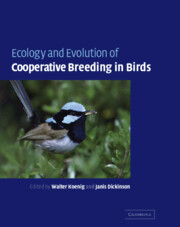Book contents
- Frontmatter
- Contents
- List of contributors
- Introduction
- 1 Evolutionary origins
- 2 Delayed dispersal
- 3 Fitness consequences of helping
- 4 Parental care, load-lightening, and costs
- 5 Mating systems and sexual conflict
- 6 Sex-ratio manipulation
- 7 Physiological ecology
- 8 Endocrinology
- 9 Incest and incest avoidance
- 10 Reproductive skew
- 11 Joint laying systems
- 12 Conservation biology
- 13 Mammals: comparisons and contrasts
- 14 Summary
- Names of bird and mammal species mentioned in the text
- References
- Taxonomic index
- Subject index
10 - Reproductive skew
Published online by Cambridge University Press: 02 December 2009
- Frontmatter
- Contents
- List of contributors
- Introduction
- 1 Evolutionary origins
- 2 Delayed dispersal
- 3 Fitness consequences of helping
- 4 Parental care, load-lightening, and costs
- 5 Mating systems and sexual conflict
- 6 Sex-ratio manipulation
- 7 Physiological ecology
- 8 Endocrinology
- 9 Incest and incest avoidance
- 10 Reproductive skew
- 11 Joint laying systems
- 12 Conservation biology
- 13 Mammals: comparisons and contrasts
- 14 Summary
- Names of bird and mammal species mentioned in the text
- References
- Taxonomic index
- Subject index
Summary
Cooperatively breeding birds span a huge range of social organization, defined in part by the number of individuals of each sex and their reproductive roles within the group (Brown 1987; Stacey and Koenig 1990a; Cockburn 1998). In some species or groups, individuals of one sex share reproduction roughly equally, while in others a single individual monopolizes reproduction by that sex. Reproductive skew theory attempts to understand this variation in the partitioning of reproduction among individuals of the same sex. Such variation can be quantified as “reproductive skew,” ranging from 0 (egalitarianism) to 1 (monopolization). A key assumption of many models of optimal reproductive skew is that dominant individuals control the reproduction of subordinates, but that in some circumstances allow subordinates to share reproduction as a way of enlisting their cooperation (Vehrencamp 1979, 1980, 1983a, 1983b; Emlen 1982b). Dominants therefore determine the partitioning of reproduction and the magnitude of skew through the size of the reproductive “concession” granted to subordinates. Reproductive skew models were originally designed to explain variation among species, but are also applicable to variation within species and even within single populations (Emlen 1995; Reeve et al. 1998).
Within the last decade there has been a resurgence of interest in reproductive skew, stimulated in part by the ability to use molecular methods to determine parentage and thereby quantify skew.
- Type
- Chapter
- Information
- Ecology and Evolution of Cooperative Breeding in Birds , pp. 157 - 176Publisher: Cambridge University PressPrint publication year: 2004
- 53
- Cited by



